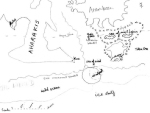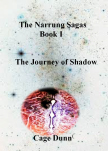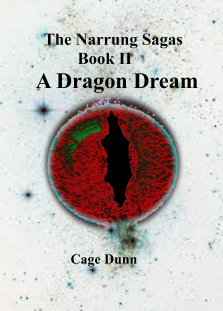Cage Dunn's Blog, page 83
December 17, 2016
2016 – The Year in Review
Did I reach my goal? Achieve what I set out do?
In the beginning, it was the purpose of learning the ropes in the e-world (yes, I know; I was an IT person – but that was mainframe, not modern stuff); this was a place to put my face without the face being visible (that’s me: the invisible person); it was the place to discuss the books – and the goal was to write five books.[image error]
I did better: Six books.
Moordenaar, which became The Blood List (mistake to change the name though); which became retired – it could be brought back at a later stage, but Neo Noir could be a bit dark for the other titles. Goodnight, sweetheart. I shall dream of you.
But it was complete and published.
The Journey of Shadow, Book I of the Narrung Sagas: Complete (not retired, but needs serious surgical restructuring).
A Dragon Dream, Book II of the Narrung Sagas: Complete.
Unknown Sins: Complete (now retired – needs surgical restructuring): Complete.
Speculations of a Dark Nature (compilation counts as a novel length work): Complete.
The Third Moment, not yet published because I’m too late for the Christmas market so I’ll let it rest until the week between Christmas and New Year and do a final review before publishing, but: Complete.
That’s six novel length works, and my goal: Five Books in a Year.
If I want to be picky about it, the first draft of Shadow was complete before the year started (well, most of it), and Moodenaar was in a 50/50 complete outline state, and Unknown Sins was fairly well formed (but in a different genre) and some of the short stories were already written – but:
Going into next year with the same goal of five books a year, I have:
Two stories in outline;
42 (yeah, I need distraction sometimes, it seems) shorts in various states of undress;
17 ideas for novel-length stories with some accompanying notes.
And I still have to make time to do the artwork, the publishing, the spreading of the word. Oh, and reading up on the craft skills I need to work on, remember, and use.
So, all in all, I did what I set out to do – and better.
And next year?
Five novel length (well-structured and well-written and well-received) books published;
Two competitions (one story, one literary);
And a new web-site to write for (5bayby14u) which I’m helping to set up (and will be contributing a once a week blog post!).
Yeah, Five books a year, and two blog sites (might have to do a once a week here and a once a week post there – we’ll see), and two competitions, and keep learning. And keep doing – and before you know it, I’ll be looking back at this post and asking the question again, but this time with emphasis on something different:
What will be the aim (for 2017) from the effort of the writing? I think I might have to look at whether the hours put in achieve any ledger activity.
Goal 4: earn some real dosh.
Next week: Q3.
See you then!


December 16, 2016
The Second Quartile
This is the maddening part of the process of structure (this is the first quartile if you missed it!) – the Second quarter of the story.
The first one was the set-up and contained the inciting incident (sometimes referred to as Catalyst) and the first plot point. It was very dramatic, very interesting, and everything led to a specific point – yes, the first plot point.[image error]
So what happens in the second quartile? The MC (that’s Main Character) reacts to the 1PP (1st Plot Point). Runs and hides, or hides and runs, or tries to get people on-side, or tries to get people out of his (for this occasion, the MC is ‘he’) life, or he acts like every other human being (or sentient being) who has just had his life hit the fan with a load of [you know what] – he’s Reacting to the situation and trying to figure out what to do about it. He may even try on some things, but these will be first dimension things – and of course, they don’t work, or they don’t work as expected, because [pause for dramatic effect] he hasn’t yet figured out how to put his whole heart and soul, his character arc part, into the effort of change – he can’t yet fight back with his whole being because he’s not yet learned all he has to learn about himself.
That’s the first half of the 2Q (2nd quartile). The next bit, some people call it a pinch point (this is PP1, Pinch Point 1), is the point where the baddie gets centre stage. Not necessarily from baddy POV, but its where the reader has to meet, see, feel, experience what it is that stands in the way of the MC. And I do mean FEEL. The reader has to experience the fear of whatever it is that is the representative of the obstruction for this story. And then he has to react to that and move onto the next main point.
Everything in 2Q leads to the next biggest point in the story: MidPoint (or the beginning of 3Q). Build the pieces (scenes) up to the monster in the room – and then watch as it falls off the edge of the waterfall. The world is turned on its head – again, but worse! [monster, ghost, chipmunk, devil, whatever word you choose to use at that point – but I preferred not to say elephant, ’cause I don’t want to envisage an elephant going over the waterfall. My choice.]
The 2Q isn’t the quickest section of the story, but it can be the most interesting. Why? [image error]Because this is the place the MC can show the depth of three dimensions of character. The outer, surface things that represent him, the inner demons that haunt him, and the first step to recognising (ie the beginning of knowledge which will come in useful when he finally decides to Act) the first steps required to change his life (which is the 4Q, so we’ll get to that later).
And the lead-in here is that the MidPoint is either a false positive or a false negative (see McKee, Robert: Story for what that means) because there’s another part later (PP2) where the opposite emotive aspect will be applied to the MC journey.
So, Q2 is the Reaction, Meet the Monster, and Lead to the Mid.
Simple. Q2: React to 1PP, Meet the Monster in PP1, move onto MidPoint.
Now, go right ahead and do it (I’m watching). I’ll be back with Q3 for the next post.


December 13, 2016
Is It Real?
On continuing the path to writer-hood (the gooderer type), I have tried to master the concept of structure, of form – and how to create from it the bespoke, the original, the ‘just for you’ story. [image error]
Yes, stories have a format – they start at a beginning. Not THE beginning, but they start somewhere and they end somewhere and in the middle is the fun stuff.
The first skill to master is: Imagery. Nothing to do with words at all. It’s the title and the cover (if it were a movie, it would be the poster). These two things must be the first beacon to the reader – the title to say what it is, to evoke the sense of the type of story and if it’s what we (the reader) want to read; the picture on the cover tells its own story, gives the genre and audience, and beckons to the ones who like this type of story. That’s their job, and if it’s not done well, the book doesn’t open to tell the story to anyone.
Two things – and no sentences yet. Title and Cover have their own format, their own way of communicating the story that will unfold beneath them.
We go inside: to the hook. What is a hook? I mean, I go fishing, I know what a hook is when I’m fishing. But a hook made of words? In the first stage of the story? Is it a small intrigue, something that catches attention? Is it a big thing? Blow-em-up thing? Answer: It’s not always a big thing, it’s not always loud, it’s not always an intrigue. Sometimes, it’s just the way the person is presented to us in those first few pages, in the set-up. Do we (the reader) feel something for this person? Can we put ourselves in that place? Would we make the same choices? Are we connected?
The hook is the emotional connection between the character (story) and the reader. It doesn’t usually involve bait or making the reader bleed (except maybe the heart).
Now that we know the person on the pages, now that we accept who they are and how they are, we wreck their world. We put in the inciting incident, and turn everything upside down – well, not quite yet, but it’s the first step to doing that. We upset the applecart, toss their dreams to the wind and watch them blow away in the storm. And we do it for the prospect of change – physical, emotional, spiritual, psychological – inner and outer is where we look to make these changes for this story. We set up the things that need to change, and then we dump the bucket on ’em.
The next point is to slow it down, give the character time to consider the options – of course, we know they’ll do this or that because it’s the type of person they are – right? they need to make their own decisions about the way forward, find options and lay out the reasons for each option being the right way, the only way. The main character makes a decision (good or bad, it belongs to them as part of their pattern f growth). And then they move on to:
The First Plot Hole in the Road. The Big thing that the first 25% of the story has led us into. The moment of no-turning-back because the decision’s been made. The whole world has been turned upside down, and things do not look the same at all. So where to go to from here?
Swear word here, please. Because what’s above is the first 25% of your story in terms of form (not formula), the basic structure that the rest of the story (the fun stuff) will be built from and into.
___
Next post will be the next 25% – which is what happens between the end of this section and the MidPoint of the story. And it’s . . . tune in to find out!
And the reason for the title to this blog: Is It Real? That’s the whole purpose of a story – to feel real to the reader, at the very least emotionally.
___
There’s a little trick some people use to create either story or blurb or concept – and that’s the one or two sentence log-line. It’s an idea turned into an interesting concept. Here’s one (you tell me if it’s interesting):
Concept: What if hell exists and it eats away at everyone while they dream – until its strong enough to break out into the real world – Soon.
Turned into blurb:
A lonely young woman fights off anyone who tries to get too close – she’s afraid the dreams will get them, so she pushes them away for their safety, for their sanity. And then she meets the man of her dreams – the good dreams, that is – and they have just one night together. Nothing left but that thing on the wall – and her broken heart and mind. But now hell has her scent, it knows what she can do, and it’s coming for her.
the above is from The Third Moment (title subject to change, maybe blurb, maybe . . .).
___


December 10, 2016
Broken Things
There are rules for everything – everything – everything! I can’t abide so many rules for so many things. I want to break some rules – I want to break out of the rules – I want to be free!

I can’t remember how many times I heard this (or similar) from my foster kids as they came to know my house and its rules. It didn’t take long, really, for them to learn that all those rules they railed against were a form of protection – but flexible, and useful, and enlightening.
The first thing they learn is the three unbreakable rules (I’m not going to say what they were because they belonged to us; needless to say, these three rules were inflexible), and that every rule on the list below those three could be manipulated – if the argument for doing so was good enough. And by argument, I don’t mean loud voices (the first loud voice argument is lost immediately – and that’s also something learned very quickly), I mean putting forward your reasoning, getting backup from other ‘powerful’ friends (the other kids), and putting up a balancing proposal.
What is this?
This little process is something I learned from my first foster teenager. He got so annoyed by my reference to all the unwritten rules I kept mentioning – after the fact – that he wrote up a list and hung it on the wall – and added to it each time one of the unwritten rules was spit out.
It was a long list, hung from the ceiling to the floor! We went through it and through it and through it and found the three rules I could not be flexible with – and created a new list. The new list had those three at the top, in red, thick and bold and clear. They were then sewn into a piece of upholstery material (a long piece) and that was tacked up on the wall (we moved a lot, had to be able to take it with us). Then the other rules went on.
These were written on paper and pinned to the ‘scroll’ of the main list in a place appropriate to the reasoning for its existence. Right down the bottom, about rule no. 311, was the one about always taking the shoes off at the door. I mean, who really cares that much about whether the kids take the shoes off before they come inside? But I did appreciate it, and the kid on the roster for cleaning the floors appreciated it, too.
And that’s how it worked.
If the rule had an impact on, or made their life easier, they found a way to live with it. If it needed to be put aside for a moment (a very good reason, that is) they brought it to the table (yes, the dinner table, post eating) to make their argument.
“I’d like to go to ‘this place’ but it’s a school night, so I propose to ‘do this in exchange’ and ask for a vote of support.”
If they got enough support (creates skills in negotiation, socialisation, politics, etc.), it passed, regardless of what I felt (I could always make a plea, couldn’t I?).
So you see, that’s how it works!
Of course, there’s a lot more to it than that, but the basic principles! And it only ever took one example in front of a newcomer for them to learn how to bend the rules! Oh, how I love to bend the rules!


December 8, 2016
I’m Back . . .
Scary, isn’t it? I disappeared down the hole (of review/revise/edit) and disappeared. Head down, bum up and nothing else existed. And today – the head popped up, the notebooks and papers and torn-up bits of yellow, pink, blue (etc.) sit on my desk (who was it said “creativity is not a pretty sight” – was it that orange cat?) and wait for me to arc up the computer, open the appropriate document and get stuck in.
Wait, wait, wait. Don’t go off half-cocked (as in, don’t shoot yourself in the foot just yet). Place the items in the locations so they are easily visible at the right time, so you don’t have to stop to find them, so you don’t think ‘I know I dealt with that – but how? Where are the notes!?’ type of things.

The hole to the mind
I’m sure you know what I mean – lots of scribbles, lots of red pen on the printed draft, lots of pages ripped from notebooks (like when you were down the shop the other day, the thought came, and ‘what, no paper?’ so you asked someone if they had a piece ‘no’ and you grabbed a bit of stuff (out of the bin! Yewwww!) to write it down before it got forgot. That’s here, too – and it was important (see!) because it fixed that little (big) problem with the segue from this to that, from big conflict to inner conflict.
Put them out so the most important locations are easily visible as you get to the part that needs that little bit of healing, the bit of medication, the tiny cut of surgery (well, maybe more than tiny – but it will heal), the stitches and patches and coo-words (pats and caresses for the kids who feel left out).
So, how long was I gone? When did I go down there? Really? That long ago. Didn’t notice. Did anyone miss me?
Nope, not a one. Not even sure if anyone noticed. It must be ‘normalised’ now. I don’t think I even hear the words “It’s alright, she’s editing,” or shrug “she writes,” are words I’m sure I hear every now and then – oh, hey, it wasn’t a character, was it?
Do I miss the world around me (the real one!)? Can’t say I do. It will be the same, or close to it, when I come out as when I went in – it will, won’t it?
Who’s that person? A beard? When did that happen?
Maybe I should take a day or two before I do the next stage of the process and disappear down the other shaft . . . Oh, you’ve got things on tomorrow – okay. No, I’m fine – I’ve got work to do; see you on the other side!
I treasure that everyone else is busy with their own stuff; that I have my own treasure to dig out of my head.


December 5, 2016
Going down, hold onto me,
I’m going down, and down and down . . .
Almost disappearing, doing the vanishing act, down the tube . . .
Where to this time? Into the WIP The Third Moment now into it’s final draft stage prior to editing (and this time, it will be the structural edit that is first, then the others).
It’s printed out, the words are there in black ink on white paper, the outline and ‘markers’ for the story are in the notepad, ready to keep the story (me, really) on track, disallowed from wandering off down the wrong path, the irrelevant (story) path – and the RED pen sits there, waiting, like a beacon.
It’s a good thing – the draft is complete (again) and ready to be investigated, to be made into the best story, interesting, unique, compelling.
But of course, I can’t tell that – not yet. It takes some distance, and some time, and some clarity (usually from another voice – and not the one in the writer’s head) to impart that necessary constraint, to give a reader’s eye view of the attributes and sense and purpose of the story.
So I have to step back, hand over the ‘draft’ to someone who’ll read it like a true reader, but also like a mentor, a teacher, the person who picks apart the threads that don’t belong, or don’t say what they should (what the writer thought they said).
And when this happens (thick skin required), I have to consider that the story is its own life; once the words are put together into the ‘product’ it’s not mine – it has its own life and reason for being, which is why it’s so important that it be compelling.
I know the idea is something distinctly Australian, a bit new (yes, I know – same, but different) in terms of idea, but the story is still one of the many tropes – could it be Monster? or Horror (not splatter)? or . . .
This is the time to seriously consider how I label this story with a genre (or genres) so it can go out with the right readers in mind – so they can find it. It’s something I have trouble with, so I’ve asked the reader/s to try that hat on, too. I wonder what they’ll come back with? Will it be the same as I think? Or will it be something else? Will it be compelling? or interesting? or . . . not?
This is the time to find these things out, to prepare for and manage the implementation of the concept of words that compel and propel the story from one point to another – before it vanishes into the abyss with the hundreds of thousands of other titles out there that aren’t . . .

It’s not that sort of magic, it’s the magic of . . .


December 3, 2016
What Was I Thinking?
I wish I could remember – I know it was good – it was all planned out, structured to spruik with the best power and . . . but it’s gone.
The times you lay in bed – should be asleep, should’ve been asleep hours ago – and all of a sudden, there’s this great idea, these great words, and they come so easy, they fall all over themselves in just the right way (or should that be ‘write’ way?) and it’s soooooo exciting!
I just have to remember what it was when I wake up – or should I get up now and write down at least the bones? – because I know (and I know you know) the words – or even the basic idea – will be gone by the time the night becomes the next day.
And that’s what happened. There was nothing there but the memory that it was good, it was great, it was magic. Like all magic, it moves on without a hint of ozone or a whiff of perfume – just pfffffft! Gone.
Such a loss. Because I know how good it was – the idea, the concept, the structured play of words that created a very powerful impact. It was. I promise.
But that’s all there is that’s left – a dream of greatness.
*
Does that stop me from getting on with what the day requires?
Nope. This has happened before. It happens all the time (you’d think by now I’d know to get up and jot, or have a pen and pad by the bed [but there are other considerations there!] or that I’d just enjoy it and let it go), so I go on knowing (yes, there’s a light) that if I could do it then, it’s going to happen again. It may not be the same words, it may not be the same idea or such a great and unique context or character or structure – but if the mind can think that way at any time, it can do it again when I’m listening better.
It means my current WIP can benefit from the knowledge that I know things are improving, that I’m learning and growing and taking notice of how and what and why things need to be improved.
I know that the craft of writing is a craft like cooking (which I can’t do and if I’m perfectly honest – don’t much care to put that much effort into (as long as it’s mostly edible)), and requires constant learning, practice (a lot of that), listening (to the good and not so good words of advice – I mean, how do you know what’s good and bad unless you can put them up side by side and see how it affects your own work) and application of new knowledge.
We never stop learning. Even the best cooks keep up the process of learning or relearning or revising or reviewing.
And so do I.
The practical application of the skills and requisite knowledge is what counts.
How do I know?
I did a uni degree, majored in Professional Writing.
Years later (it took me years because the uni stuff was so – uninspiring – that I thought it would all be the same), I did a short course on ‘POV and Character’ (something like that). I was looking for a bit of inspiration and maybe someone to start up a critique group.
What did I get? The most amazing opening of the eyes to a skill of the craft spoken in a way that made it all easy to understand and so worthwhile. It showed me how little I got from uni and books and eggspurts, and how much I needed to learn if I wanted to do this thing I can’t live without.
I’ve now done all (not quite, but almost, and some I’ve done twice because my notes don’t quite capture the whole essence, or I need to re-hear the message behind the words, or . . .) those short courses and learned so, so, so much.
But that’s not the end. Courses do not the writer make – it is the application of that learning in the craft of storytelling that moves the learning into the doing into the breathing effort of a STORY.
*
So, after all that: I’d like to thank the readers who love the Narrung Sagas and bought the Shadow book (four digits), and I’d like to apologise that it’s not the best thing out there, but one day (and soon – they get better with each one!) the books I put out there for you will be the best story you ever read.
Know why? Because I keep learning; because I keep loving the way the words take on structure and meaning and play the story to someone else; because that’s what I do.
One day (maybe on the anniversary of the Shadow publication) I’ll go back and do some surgery to improve it, based on what I’ve learned since. Or do you want me to do it now? Before Book III? You tell me, okay?

The Writer Hard at Work
*


December 1, 2016
A Dragon Dream






The blurb:
All the dragons, and not just the youngers, need to find their magic – or bargain for it with the Masters of Magic. Will the cost be too high; will it force the dragons to deny their promise to protect the people who saved them from the enemy across the sea?
The three, Shadow and Pax and Gheis, have their own paths through this journey of war with the Ashans and the fear of the failing gate – and the monsters who will come through to destroy all. They will be used by the Magic to achieve the needs of the world. Their lives will be forfeit if they fail, and not only their own lives, but the lives of the family, their friends, the people of Narrung. This world and the beings in it would end; the Beast of Kaleanae doesn’t have the knowledge to stop them. They will all die, be unmade. Dragons will cease to exist – in all times, in all planes, removed from all memories, from all worlds, unless . . .
* * *
A mid-book excerpt, for your enjoyment:
Copyright Cage Dunn 2016.
_______
Her legs felt glued to the earth. Her stomach by turns cramped and dived. They would fight at night, in the dark. The enemy had their own light, and a form of engine that moved the ships against the current, against the wind, and they came on as relentlessly as ants to a carcass.
The horizon disappeared into the blackness of night, left specks of reflections. What was that? More lights? There couldn’t be that many stars; she’d never seen so many white reflections on the ocean – what was it?
And then she saw what made the lights. More Ashan ships came over the horizon, and more, and more. Not reflections; ships that came in at an angle from both north and south. Hundreds, more likely thousands, of the huge ships.
Shadow ran back up to the highest point, right up to the tip of the bluff, requested the largest scope-in from the Watch-guard and looked through the lens as she adjusted it to the highest level. Her shoulders slumped, her mouth fell open.
“Yeah,” the soldier said as he held out his hand for the return of the scope. “There’s a lot more to come.” He swallowed and lifted the scope to his eyes, kept up the commentary to his team of runners and messengers.
A lot more. She counted a group of ships within one grid, multiplied that count by the number of grids for the area covered by the white ships. Ten times more than were visible in the daylight.
They didn’t stand a chance. Even if they had the better technology, even if they had more ships and more people, even if they had dragons and dragons had magic – they didn’t stand a chance.
Fourteen hundred ships so far, minimum, and on each ship were four hundred fighters. Over five hundred thousand enemy – the largest number in the history of the wars with Asha; and the Pussers with forty seven ships that held one hundred and twenty souls on board; ten percent of the enemy, maximum. If the other ships came through, that would help, but . . . it wasn’t enough.
The Narrung soldiers and citizens who waited on the beach and inland wouldn’t number more than fifty thousand. There wouldn’t be many more to come, unless the seniors and the juniors and the swaddlers could be counted.
Outnumbered, outsmarted, out-weaponed. Out-manoeuvred.
_____
Hope you enjoyed this little taste.
And the site pages will be updated over the weekend.


November 29, 2016
A One Page Test
Can you sense the culture that comes with the first page of the story?
________ 
Two nomads reached the crest; flapping robes of once-bright red and grey, now desert-ochre-dust-red, created the only sound as one man pulled back his face-cover. She watched as both kneeled and looked down into the depression but did not step over the ridge. The prayer-singer lifted his staff and waved it in an intricate dance of song-pattern; words floated through the air – a prayer? – before they retied the face wraps and turned to descend the ridge in great leaps and bounds that took barely moments to reach the safety of the flat rocks. They’d taken several marks to climb the ridge, but almost no time to leave it. They walked away from the sole object of their long and difficult desert journey; didn’t go close enough to see it clearly.
They hadn’t gone in to touch it. No one dared.
Shadow waited until they were gone from sight before she lifted her body from the scrubby, thorny hide. An automatic gesture flicked sand and dust from her tawny brown trews and vest. Whether people knew where she was, or what she did, or why, didn’t matter. Her task was not something to discuss with travellers . . . or strangers or friends. She straightened her unruly plaited knot of hair and jammed the hat back down. This job was hers alone, and only she knew it was a task she could never reach any level of achievement with. The green cape in her pack may be an indication she’d reached the rank of Master, but she had no guild, no mentor, no guilden brethren. A guild of one, a Master of none.
The robe could stay in her pack and go mouldy; it meant nothing unless she had at least one student – and something of value to learn and teach.
She tried to be smooth, but her boots shuffled and scuffed down the steep decline, it was impossible to avoid making dust clouds, landed on the base with a thwack of leather on rock. Back into the wounded and raw landscape – not even bushes grew down here now – and felt the first stirrings of unease. The wind wasn’t a natural wind; it didn’t move so much as it breathed; it didn’t breathe so much as it writhed in pain. She shuddered; even the thought of what it was that could do that made her hair stand on end, made her eyes wide. She was afraid, very afraid. No one knew better than she that monsters were real.
The air movements eddied sand and dust over the single hump-shaped object in the middle of the depression. It may be only one of many depressions in the Sea of Sand, but this one was dangerous enough to be avoided by all. Even those protected by gods didn’t cross the outer barrier.
The outer layers of the lump in the middle was once shiny gold and platinum white and silver titanium, but was now dusted to the dull powdery ochre-red of the last few remaining red story rocks that lined the perimeter.
She could have filled her henna packet with this dust – it looked the same, coloured her skin the same, but didn’t last as long.
The shape and size of the thing underneath was indiscernible to a human eye; sand filled in the edges and sank it down until the only section visible was in the vague shape of the head of a lion – and the sound. It came from the wind that sang through the feather-like scales wrapped so tightly against the metal skin. A screeching whistle sound, like a kettle or a steam-still, a constant irritant to any who came near. It grated on her teeth, in her bones, along each hair on her body. But she was getting used to it. Just didn’t put her teeth together anymore, and slept with a peg in her mouth.
She was the only one now. No one else came here, not more than once. For some, once was enough to twist their thoughts, make them mad.
_______
That was the beginning of the story: Book II – A Dragon Dream.
Does it give the sense of location, of culture, that a first page requires?


Rubbish Day
Tomorrow is rubbish day. Each week we put out the bins – the small one for ‘regular’ garbage, and once a fortnight we alternate between the yellow bin for recycle-able items and the green-waste.
I wonder at this sense of need to hide garbage, remove it, get it out of sight. Are we doing a good job with our ‘stuff’? I call it stuff, rather than rubbish, because I was brought up to consider that you don’t pass your expletive onto another person or place. That included garbage. If it composted, it went into the compost (toilets, too – including the long-drop with the resident Snake and Spiders and a very scary place in the middle of a thunderstorm on a dark night!); if it was good enough, it went to the chooks (or other critters, including meat rabbits and sheep and . . .). If it couldn’t be composted, could it be re-used or re-shaped into something useful or traded with someone who had something we wanted and could be something they were looking for?
That’s how it went. We would trade things like greens and eggs and dried food-stuffs for other items (like the use of the butcher occasionally). We didn’t have plastic – what use was that? For food storage it was glass (if we could afford it), but mostly the food was stored in dry sand and hay and buried in sand pits. Yes, it keeps food good for a long time. If meats and fruits and fish are dried, they can be hung in a dark place and stay edible for ages. At least until the next seasonal glut came around.
I didn’t ever see garbage, or even the concept of throwing stuff away, until I moved to town.
And then it was everywhere. It was. People complained when there weren’t enough bins in the streets, around the shops, for them to chuck the paper or food or metal things into. They walked through the gutters full of cigarette butts and food scraps – and didn’t notice or didn’t care. The backs of shops – if you weren’t afraid to go back there – stank like a dead whale (or worse), and there were bins so big you could’ve slept six people in there.
Now we have waste-management strategies to try to reduce the land-fill requirements. What a stupid idea!
Want an answer? I do. So here’s one idea:
Make people responsible for their own waste. Pay by weight. Don’t have plastic that can’t be composted – anywhere in the world; outlaw the production of plastic, use a sugar-based method, or a spinifex-glue base.
Compost everything that can be so we can return the soil to a reasonable level of productivity without the need for added (oil-based) fertilisers.
Learn how to re-use anything that is a valuable resource base item (all metals can be recycled). Find ways to re-shape or re-purpose or re- anything that doesn’t involve a greater use of energy than it did to create the object in the first place. Find a way to produce things that doesn’t take so much energy consumption.
You get the idea? Good. Now spread it around. We (each one of us) can decide to be a no rubbish person, or at the very least, a minimum garbage producer.
Set a number: I will produce no more than 1kg of garbage per week per person in my household (as an average over the year, maybe?). It shouldn’t be too hard if you separate out the things that can be recycled, composted, or otherwise re-used.
Don’t buy stuff that involves automatic waste elements. Take the material-based shopping bags (the ones that can be chucked in the washing). Don’t get me started on laundry. Please!
Just start with the rubbish-reduction idea first. Please help.
* * *
In the meantime, I’m still working on the second-stage edit of A Dragon Dream. It’s looking better.





